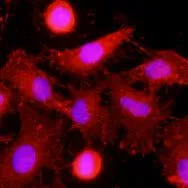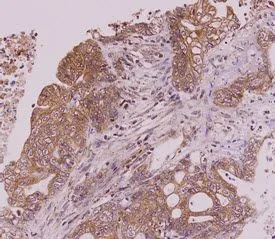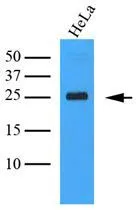
ICC/IF analysis of HeLa cells using MINCLE antibody antibody at a dilution of 1:500 (Red). Nuclei were stained by Hoechst 33342 (blue).
CLEC4E antibody [AT16E3]
GTX53742
ApplicationsFlow Cytometry, ImmunoFluorescence, Western Blot, ELISA, ImmunoCytoChemistry, ImmunoHistoChemistry, ImmunoHistoChemistry Paraffin
Product group Antibodies
ReactivityHuman
TargetCLEC4E
Overview
- SupplierGeneTex
- Product NameCLEC4E antibody [AT16E3]
- Delivery Days Customer9
- Application Supplier NoteThe antibody has been tested by ELISA, Western blot and Immunofluorescence analysis to assure specificity and reactivity. Since application varies, however, each investigation should be titrated by the reagent to obtain optimal results. Recommended dilution range for Western blot analysis and Immunofluorescence is 1:250 ~ 500. Recommended starting dilution is 1:250
- ApplicationsFlow Cytometry, ImmunoFluorescence, Western Blot, ELISA, ImmunoCytoChemistry, ImmunoHistoChemistry, ImmunoHistoChemistry Paraffin
- CertificationResearch Use Only
- ClonalityMonoclonal
- Clone IDAT16E3
- Concentration1 mg/ml
- ConjugateUnconjugated
- Gene ID26253
- Target nameCLEC4E
- Target descriptionC-type lectin domain family 4 member E
- Target synonymsCLECSF9; C-type (calcium dependent, carbohydrate-recognition domain) lectin, superfamily member 9; C-type lectin domain family 4 member E; C-type lectin superfamily member 9; macrophage-inducible C-type lectin; MINCLE
- HostMouse
- IsotypeIgG2b
- Protein IDQ9ULY5
- Protein NameC-type lectin domain family 4 member E
- Scientific DescriptionThis gene encodes a member of the C-type lectin/C-type lectin-like domain (CTL/CTLD) superfamily. Members of this family share a common protein fold and have diverse functions, such as cell adhesion, cell-cell signalling, glycoprotein turnover, and roles in inflammation and immune response. The encoded type II transmembrane protein is a downstream target of CCAAT/enhancer binding protein (C/EBP), beta (CEBPB) and may play a role in inflammation. Alternative splice variants have been described but their full-length sequence has not been determined. This gene is closely linked to other CTL/CTLD superfamily members on chromosome 12p13 in the natural killer gene complex region. [provided by RefSeq, Jul 2008]
- ReactivityHuman
- Storage Instruction-20°C or -80°C,2°C to 8°C
- UNSPSC12352203


